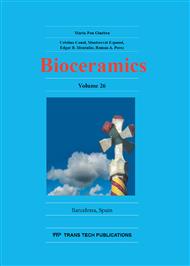[1]
X. Liu, P.K. Chu, C. Ding, Surface modification of titanium, titanium alloys, and related materials for biomedical applications. Mater. Sci. Eng. Rep. 47 (2004) 49-121.
DOI: 10.1016/j.mser.2004.11.001
Google Scholar
[2]
B. Surowska, J. Bienias, Composite layers on titanium and Ti6Al4V alloy for medical applications. J. Achiev. Mater. Manuf. Eng. 43 (2010) 162-169.
Google Scholar
[3]
S.V. Dorozhkin, Calcium orthophosphates. J. Mater. Sci. 42 (2007) 1061-1095.
Google Scholar
[4]
R.A. Rosu, V.A. Serban, A.L. Bucur, U. Dragos, Deposition of titanium nitride and hydroxyapatite based biocompatible composite by reactive plasma spraying. Appl. Surf. Sci. 258 (2012) 3871-3876.
DOI: 10.1016/j.apsusc.2011.12.049
Google Scholar
[5]
T. Chandra, K. Tsuzaki, M. Militzer, C. Ravindran, Plasma spray deposition of hydroxyapatite coatings from sol precursors. Mater. Sci. Forum 1128 (2007) 539-543.
DOI: 10.4028/www.scientific.net/msf.539-543.1128
Google Scholar
[6]
A. Carradó, Structural, microstructural, and residual stress investigations of plasma-sprayed hydroxyapatite on Ti-6Al-4V. ACS Appl. Mater. Interfaces 2 (2010) 561-565.
DOI: 10.1021/am900763j
Google Scholar
[7]
H.M. Kim, F. Miyaji, T. Kokubo, T. Nakamura, Effect of heat treatment on apatite-forming ability of Ti metal induced by alkali treatment. J. Mater. Sci.: Mater. Med. 8 (1997) 341-347.
Google Scholar
[8]
F. -H. Lin, Y. -S. Hsu, S. -H. Lin, T. -M. Chen, The growth of hydroxyapatite on alkaline treated Ti-6Al-4V soaking in higher temperature with concentrated Ca2+/HPO42-. Mater. Chem. Phys. 87 (2004) 24-30.
DOI: 10.1016/j.matchemphys.2004.03.030
Google Scholar
[9]
A.C. Tas, Electroless deposition of brushite (CaHPO4·2H2O) crystals on Ti-6Al-4V at room temperature. Int. J. Mat. Res. (formerly Z. Metallkd. ) 97 (2006) 639-644.
DOI: 10.3139/146.101283
Google Scholar
[10]
A.C. Tas, S.B. Bhaduri, Chemical processing of CaHPO4·2H2O: its conversion to hydroxyapatite. J. Am. Ceram. Soc. 87 (2004) 2195-2200.
Google Scholar
[11]
B. León, J. Jansen (Eds. ) Thin calcium phosphate coatings for medical implants, Springer Science+Business Media, LLC, New York, (2009).
Google Scholar
[12]
J. Xu, I.S. Butler, D.F.R. Gilson, FT-Raman and high-pressure infrared spectroscopic studies of dicalcium phosphate dehydrate (CaHPO4. 2H2O) and anhydrous dicalcium phosphate (CaHPO4). Spectrochim. Acta A 55 (1999) 2801-2809.
DOI: 10.1016/s1386-1425(99)00090-6
Google Scholar


